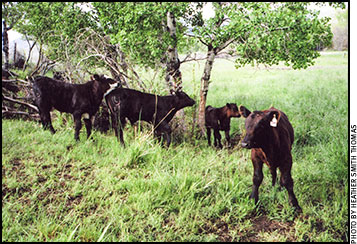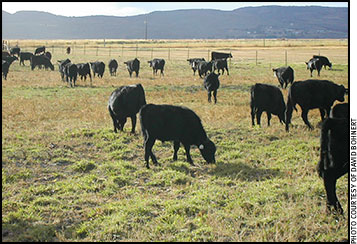Prep for Parasites Before the Feedlot
Research shows advantage of deworming calves ahead of feedlot entrance.
Cattle on pasture pick up parasites. Worm level in any group of cattle depends on how heavily contaminated the pasture is and whether the cattle have natural resistance to nematode infections. Calves have not yet developed much resistance and tend to have heavy parasite loads if pastures are contaminated. Worm eggs passed in manure hatch into larvae that migrate onto grass.

Producers have believed that deworming upon feedlot arrival can effectively rid cattle of parasites, but data suggest detrimental effects of those parasite burdens on growth and performance may be long-lasting.
Severe infections often result in decreased growth, rough hair coat, reduced performance, decreased appetite, and sometimes diarrhea and weight loss. Even if cattle are not showing clinical signs, strategic deworming improves performance and weight gain in beef herds.
Cattle are usually dewormed after arrival at feedlots. One treatment is usually all that’s needed, as they have minimal exposure to worms in a feedlot environment. Studies during the 1960s and 1970s showed that unexposed or uninfected calves gained weight more rapidly than infected or infected and medicated calves. Infected medicated calves that were dewormed at feedlot entrance gained 4% faster than untreated counterparts. Later studies showed that of all available pharmaceutical technologies, deworming had the greatest effect on production efficiency and cost of production, but very few looked at how parasite load at feedlot entrance might impact performance and subsequent health in the feedlot.
A study by researchers at Iowa State University by C.A. Clark and co-workers (published in Professional Animal Scientist, issue #31, 2015, page 412) utilized data from 36 southeastern calves that were individually assessed for fecal egg counts from fecal samples upon arrival at the feedlot.
The calves were divided into two groups — high or low initial fecal egg counts. Calves in the high group had fecal egg counts of more than 100 per gram of feces. The low-group calves had less than 100. All calves were dewormed after initial evaluation. All were implanted, fed in a single pen and harvested after 179 days on feed when average 12th-rib fat cover was estimated to be about 1.15 centimeters (cm). Final weight was measured individually before shipment to the harvest facility. After harvest, hot carcass weight and carcass characteristics (quality grade, marbling, fat thickness, etc.) were measured and recorded by USDA personnel.
All animals were individually evaluated for feedlot growth performance, health, carcass characteristics and data collected to determine the proportion grading upper two-thirds Choice or greater, proportion obtaining a carcass yield grade of 1 or 2, and proportion treated after feedlot entry.

Calves with high parasite burdens at the beginning of the study brought about $50 less per calf and had decreased carcass quality.
Producers have generally believed that deworming upon feedlot arrival can effectively rid cattle of parasites and reverse detrimental effects of high worm burdens during earlier grazing, such as on their dams or as stockers. Data from this new study suggest that detrimental effects of those parasite burdens on growth and performance may be long-lasting, despite effective deworming at feedlot arrival.
The high group tended to have lower weight gain and more high-group calves were treated for illness and received more frequent retreatment than calves in the low group. Treatment costs were four times higher for calves with high initial fecal egg counts than with low initial counts.
The high-group cattle were unable to make up for their poor start. Backfat and marbling scores were lower for high-group calves. The tendency for less backfat, ultrasound longissimus muscle (LM) area, and marbling scores support the idea that cattle with heavy parasite load at feedlot entrance may take longer to reach market-ready carcass composition. The trend for a lesser LM area among the high group suggests a lesser amount of muscle production. Reduced feed intake at critical points during the grazing period may have hindered overall muscle production in highly parasitized calves.
Overall, the high-group cattle brought less total income per steer ($1,380) than the low group ($1,412). Increased marbling scores often translate to higher quality grades and higher carcass values when sold on a grid. Results of this study suggest that cow-calf producers who retain ownership through feeding would benefit from deworming calves during the grazing period before sending them to the feedlot. Producers who sell to repeat buyers may find that dewormed calves are desired by the cattle feeder who benefits from lower treatment costs and higher-grading carcasses.

Editor’s Note: Heather Smith Thomas is a cattlewoman and freelance writer from Salmon, Idaho.






